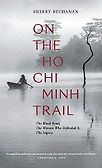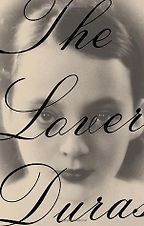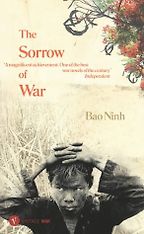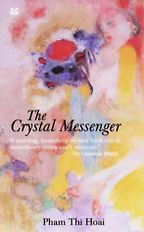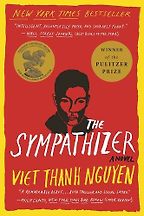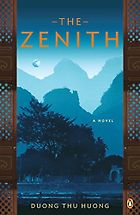You’ve chosen some amazing novels about Vietnam. Can you tell me how you set about choosing them, what your criteria were in selecting these particular ones?
I chose each one because they were groundbreaking at the time they were published. They were radical for various different reasons and, except for Marguerite Duras’s The Lover, were the beginning of a new trend in translated Vietnamese literature and in literature by Vietnamese-American authors.
They’re really, really nice books. I also got the impression, looking down the list you sent me, that you were trying to cover different periods in recent Vietnamese history?
Exactly. So, I started with The Lover by Marguerite Duras, because it’s a narrative of life in French colonial Vietnam. It’s the story of a French Catholic schoolgirl whose family has fallen on hard times and of her consensual but scandalous love affair with a rich Chinese Vietnamese. He was 25 and she was only 15 at the time.
At the beginning she is attracted by his wealth, but she realizes, in the end, that he was her first love. It was a real reversal of the white expat male with a Vietnamese girl that you see in Graham Greene’s novel, The Quiet American. It broke those stereotypes. It’s radical and it’s an adventure. It just appealed to me when I first read it. It became a bestseller and a million copies were sold.
It’s a work of autofiction, as I think the genre is called. It’s written as fiction, but it’s actually about Marguerite Duras’s life?
Yes it is autobiographical. She wrote it much, much later, when she was 70 or so. It’s interesting that it took her all that time to decide that this had been the defining moment in her coming-of-age. Years after their affair, the Lover (Huỳnh Thủy Lê) on a trip to Paris with his wife, phoned Duras to tell her that “he still loved her, that he would never stop loving her, that he would love her for the rest of his life.”
And does the book give a good picture of what life in French Indochina was like?
There’s no exoticism and it’s not descriptive. Duras’s style is terse, intimate. It’s much more about inner feelings. All she needs are two or three words to place you in the situation she’s in. It’s about the interactions in her very dysfunctional family, about rebelling against social mores both because she’s so young and because she’s having an affair with a Vietnamese.
The novel shows the underbelly of French colonialism and the inherent racism of the time. I was brought up in the French school system, with exotic pictures of beautiful ladies in French Indochina. This book was, for me, a wake-up call to the realities of French colonialism, which were pretty grim. After her father died, the family lived in relative poverty; her parents were teachers and had gone to Indochina as part of what the French portrayed as their ‘mission civilisatrice’, their civilizing mission. In the book, it’s anything but. But the book does not address the crimes of the French colonial regime I discovered later, when I travelled there. That’s another subject, which still hasn’t been covered within French or Vietnamese literature, and which should be.
Let’s move on to North Vietnam in the 1950s and 60s, which is the setting of the next of the novels you’ve chosen, The Zenith. This is a work of historical fiction, is that right?
Yes, it was published in English in 2013 by Dương Thu Hương, a great Vietnamese novelist, and it was quite an explosive book. During the Vietnam War, Dương Thu Hương served with a North Vietnamese Youth Brigade. After the war, she advocated freedom of expression and was arrested and imprisoned without trial in 1991 for allegedly attempting to send confidential documents out of the country. She now lives in exile in Paris.
It’s a historical novel that reads like a gripping political thriller. She takes on a controversial subject: the inner circle of Ho Chi Minh, president of North Vietnam from 1945 until his death in 1969, and hero of Vietnamese independence. He was beloved by millions in communist North Vietnam but vilified by the South. He was a mysterious personage and his life, especially in exile, is still shrouded in controversy and mystery. A biography published in 2000 by the American diplomat and academic William J. Duiker remains the only definitive work in English about his life.
“When I met General Giáp, the strategist who won the wars against the French and the Americans, his first words were to thank me for what I had done for Vietnam”
Ho Chi Minh is considered the father of the nation, and is known as ‘Bác Hồ’ or Uncle Ho. And to have Dương Thu Hương write an imagined account of his inner circle in communist North Vietnam in the late 50s and 60s that includes rape, murder and political intrigue, is quite radical. But, firstly, it’s a great novel to read. Secondly, it should spur greater investigation into this period of history, especially Ho Chi Minh’s inner circle, many of whom were hard-line Maoists. So, it is a novel but it’s well worth a read for anyone who wants an insight into that period. There isn’t much else, in English at least.
What do we know about Ho Chi Minh himself?
He had a peripatetic life. At twenty, he left Vietnam—reportedly because of his anti-French sentiments—and travelled the world working on ships. He stopped off in several countries, including the United States and the UK. In 1913 he worked at the Carlton Hotel, in Haymarket in London. It was in Paris that he first joined the Socialist Party, became a member of the Intercolonial Union affiliated with the French Communist Party and left for Moscow where he was employed by the Communist International.
He launched the Indochinese Communist Party in exile in Hong Kong in 1930. There he was saved by the British, I only learned recently. The French wanted to execute him and the British intervened. During World War II, he returned to Vietnam as the leader of the Viet Minh, the communist-led national alliance that fought the war of independence from the French (1946–1954). In Vietnam, he is a saintly and celibate hero dedicated to the revolution.
Let’s move on to The Sorrow of War by Bảo Ninh, which is a beautiful, beautiful book about the war against the Americans.
The Sorrow of War was another groundbreaking novel. You can’t not include it. Dương Thu Hương also wrote a novel, Novel Without a Name, about the war. As you’ve noticed many of the books are autobiographical, but they’re novels. For Vietnamese authors, I think that has to do with censorship. It’s a way to write about events in a freer way.
It also makes The Sorrow of War very powerful.
It is very powerful. At the time it came out, in the 1990s, the North Vietnamese had been stereotyped as robotic killers and fanatic communists. The Sorrow of War was a revelation for anyone who wanted to hear the other side. Kien, the protagonist, is a soldier with the North Vietnamese Army. He is a sensitive, sorrowful soul, caught up in these terrible, terrible events. The book described, for the first time for English-speaking readers, the terrible suffering of the North Vietnamese troops: the hunger, the disease, the huge casualty rate, the desertion, the political indoctrination, the terrible fate of women. The way he writes is brief, disquieting, it’s very, very effective.
Kien is in a tragic, doomed, love affair with Phuong. The gang rape of Phuong by American soldiers was, for me, one of the most chilling, horrible events of any war novel. But Kien retains his humanity throughout the novel. It’s a poignant theme of humanity in war, in spite of all the horrors Kien experienced.
A Vietnam vet and American novelist, Karl Marlantes, recommended books on the Vietnam War for us and he recommended Bảo Ninh’s novel. He said, “He was born in North Vietnam, I was born in a logging town in Oregon. We end up in the same war on different sides and yet the experience of it is so similar.”
Yes. I think the American soldiers had more food, though. The North Vietnamese were fighting under really, really tough conditions.
Your next novel, The Crystal Messenger by Phạm Thị Hoài, is about a somewhat easier time in Vietnam, maybe: the 1980s, after the war. I couldn’t find a copy very easily.
Yes, I included it anyway because I do think it’s a graceful novel. It’s beautifully written as a stream of consciousness. It’s not about the war and there are very few novels in translation of that period that aren’t. The novel portrays a traumatized post-war Hanoi. At the end of the war in 1975, after the reunification of North and South Vietnam, the economy had totally collapsed. They had nothing.
Again, it’s bleak. It’s the story of a young woman coming of age. Her family are communist cadres and she’s a free spirit, an outsider who doesn’t accept the social mores of the time, the strictness of socialism. She describes Hanoi as a city full of faceless humans, fear and denunciations. She’s courted by a menacing man she calls Quang the dwarf whom she rejects when he proposes marriage. Quang then rises in the communist hierarchy and takes revenge by arresting her brother and imprisoning him for financial dealings. Another brother loses his opportunity to do his PhD because he’s found consorting with a woman who is supposedly a spy.
Get the weekly Five Books newsletter
The redemption in the story is that the young protagonist retains her moral compass and humanity. Growing up in this bleak time, she separates humans into two categories: Homosapiens-A, or humans who know how to love, and Homosapiens-Z, humans who don’t know how to love. It’s just a beautiful, simple category that helps this young girl deal with her world.
The Crystal Messenger is her baby sister. Born with a smile, her first word is: ‘kiss’. So you have these images of light and joy in an otherwise pretty dark picture. It’s a beautiful novel, but again, it was banned. I guess she wasn’t allowed to say that Vietnam was poor at that time. The novel was considered too pessimistic. The author lives in Berlin.
I seem to remember my Vietnamese professor at Harvard, Hue-Tam Ho Tai, talking about the idea that North Vietnam won the war but lost the peace. Have you heard that said?
They were saying that in the 90s, I think. Less so today because of the country’s prosperity and the renaissance in the arts. But certainly, the 80s and part of the 90s were very difficult times.
I know more about China and I always think of the 80s as a comparatively free-wheeling period. Vietnam didn’t follow that trajectory, I guess?
It did, after 1986 when the government introduced a socialist-oriented market economy. The economic reforms were known as Đổi Mới or Renovation. That was the kickoff. Cultural censorship was relaxed. That’s when these novels were written. The arts began to flourish. It was much, much better, although Vietnam’s economy took longer to take off than China’s did.
But The Crystal Messenger is talking about the 80s period before Đổi Mới?
Yes, she’s talking about the period between the end of the Vietnam War in 1975 and 1984, so before Đổi Mới. But she’s able to write this in 1988, so afterwards. Although it was still banned.
The freer atmosphere made it possible for her to write it, though not publish it, I guess.
Yes. Although that’s where poetry comes in, which I didn’t include, but I’d like to mention. Poetry goes back centuries in Vietnam. It was a medium throughout the ages to express yourself relatively freely. One of Vietnam’s main literary achievements is the epic poem The Tale or Song of Kiều. A new translation was published in 2019 by Penguin Classics. If we’re talking about Vietnamese literature, it’s well worth reading. It was written in 1820 by the celebrated poet Nguyễn Du.
And then the war poetry written by North Vietnamese poets sent to the battlefronts like Lâm Thị Mỹ Dạ in Green Rice is very moving. It’s lyrical, and encompasses the range of human emotions from terrible sorrow to joy. Again, more freedom to express yourself in that format than in a novel, for example, or certainly in nonfiction.
Tell me a bit about the last Vietnamese novel you’ve chosen, The Sympathizer, which won the 2016 Pulitzer Prize for Fiction. I started reading it and it’s quite gripping.
The Sympathizer is another groundbreaking publication. Viet Thanh Nguyen is a powerful new voice for the Vietnamese who left the country after the end of the war in 1975, mainly South Vietnamese who fled after the fall of Saigon in 1975 and settled in the US. For a Pulitzer Prize to be awarded to a novel written by a Vietnamese American, in itself, is a first.
The protagonist is half French, half Vietnamese. He’s a spy working undercover for the communists in Saigon and then in the US. When he returns to post-war communist Vietnam, he is imprisoned by his own side. The novel ends at sea with the narrator leaving Vietnam among a crowd of boat people.
Viet Thanh Nguyen illustrates the complexity of divided loyalties that come from Vietnam’s history—from being a colony for 100 years, then at war for over 30 years, with families split between supporters of the North and supporters of the South. There are divided loyalties, betrayals, and the loneliness and divisiveness that this creates within families. The plot illustrates the pain of broken families and friendships, and the loss of home.
Then there are the Vietnamese in exile who took US citizenship, the difficulty of that relationship, especially for the older generation. They were staunchly anti-communist but at the same time some felt betrayed by their very country of adoption when the US left South Vietnam. But now his generation are coming to the fore and his is a powerful voice.
Viet Thanh Nguyen’s generation are coming to the fore?
Yes, he’s 50. Other new American-Vietnamese voices include the exceptional writer and poet Ocean Vuong. And one of the earliest, although it’s a memoir not a novel, was Le Ly Hayslip who wrote When Heaven and Earth Changed Places and also Woman of War, Woman of Peace, turned into a film by Oliver Stone.
How did you get involved with Vietnam?
I was a journalist based in Hong Kong, working with the International Herald Tribune, at the beginning of the 90s. I focused on China post-Tiananmen Square and its transition to a market-oriented economy because that was such an interesting story. When I visited Vietnam, I was shocked at the discrepancy between the art and culture I discovered there and what I had seen on the TV news in the US when I was in university. I just couldn’t believe it. I couldn’t believe how post-war US popular culture mis-portrayed Vietnam, especially the role of women in the war.
Then, in 1995, the official estimate for civilian war dead was published, mostly ignored by the US: two million civilian war dead! I was shocked by the scale, I was shocked that the US took no responsibility for the casualties it had inflicted, or for the mess they left behind, the victims of Agent Orange, the unexploded bombs. And I just felt anger.
Five Books interviews are expensive to produce. If you're enjoying this interview, please support us by donating a small amount.
On the positive side, I discovered a world of aesthetics, culture, music, poetry, art and I thought, ‘This is something I’d like to share.’ That’s how I started. My first book was on a Vietnamese artist who painted in Hanoi during the war. I went to Thames & Hudson and they said, ‘Beautiful project, we need X amount of pounds of sponsorship’ Being a words person, I’d never really published art books. I thought, ‘That sounds like a lot. I’ll just publish it myself.’ And I created my imprint, Asia Ink. Coincidentally, a curator at the British Museum had the same passion for Vietnamese art created during the war. So we organised an exhibition on Vietnamese war drawings in 2002 that drew 75,000 visitors. That was the beginning. I kept going because there was just so much to share about Vietnamese culture.
I published two books on war art. Vietnam Zippos was the trench art of American soldiers: sex, drugs, rock and roll, f*** this and f*** that. And then there were these beautiful lyrical drawings created by North Vietnamese war artists under the same circumstances. I wondered, ‘Who is bringing civilisation to who?’
The reason we’re talking today is because of the book you’ve just published, On the Ho Chi Minh Trail, which looks absolutely amazing. Tell me a bit about it.
I did the trip from Hanoi to Ho Chi Minh City, through Laos, and then back into Vietnam, to collect stories from veterans from both sides of the frontline, mainly from the women I had seen portrayed in the war drawings.
For anybody who doesn’t know, do you want to just describe what the Ho Chi Minh Trail was?
People think of the Ho Chi Minh Trail as one path or one road but by war’s end it was a network of 10,000 miles of roads, bridges, and pipelines through Vietnam, Laos and Cambodia. It was built by the North Vietnamese Army to ferry military troops and supplies from North Vietnam to the battlefields in South Vietnam where they were fighting against the South Vietnamese and their US ally. At the height of the war, the US had half a million troops in South Vietnam.
The US Air Force, Navy and Marines bombed the Trail day and night in an effort to stop the flow—close to eight million tons of bombs were dropped—but they never managed to cut the Trail. It became a mythical, legendary road of victory for North Vietnam. But it was also a blood road, because of the huge casualties. Anecdotally, at the height of the bombings, only 10 per cent of soldiers in a unit made it to the battlefronts.
An interesting part of the trip was that I was able to link sections of the road to military events through interviews, memoirs and articles. There are still a lot of military secrets. Also, I discovered a cultural heritage and layers of civilizations that the Americans were bombing, probably unknowingly.
And women played a critical role.
This is a story that’s well-known in Vietnam, of course. Women veterans are highly decorated, heroes of Vietnam, but our history is selective, usually written by men, and usually written by the victors—though in the case of the Vietnam War, mainly written by US authors. So this aspect is little known in the West, although one excellent scholarly account was published in 1998, Even The Women Must Fight by historian and academic Karen Gottshang Turner and the journalist Phan Thanh Hảo, who was the English translator of Sorrow of War.
Women militia and soldiers fighting on the North Vietnamese side were posted on the mountainous Trail to clear the roads for the truck convoys going south. They were bombed all the time. They decommissioned bombs, which was incredibly dangerous work. They were stationed in a tough jungle environment. Again, very little food, a lot of hunger, a lot of malaria. It’s just unbelievable. They were aged 17 to 24. Some of them were from farming backgrounds, and used to working in the field, but others were from middle class families who interrupted their studies and enlisted or were drafted. Then you had the women defending the coastal Trail. An estimated 1.7 million women, married with families, defended roads, bridges, towns, and villages as more and more men were sent to fight in South Vietnam. The women played an important strategic role in North Vietnam’s eventual victory.
Vietnam’s combination of history and culture, and the war—I’ve only been once, when we were living in Beijing—but I found the country completely mesmerizing. My kids were tiny at the time and we took the overnight train from Hanoi to Danang, the Reunification Express. One of them lost a tooth, so the tooth fairy visited that night. The Vietnamese we met on the train, including the guard, were so gentle. I just couldn’t connect it with that image I had from living in America in the late 70s, early 80s, of this horrendous war.
It’s hard for visitors to juxtapose the gentleness with the cruelty of the war, it’s very hard to fathom. I don’t think of the Vietnamese at all as victims. On the contrary, they’re extremely tough and resilient and seem to have little personal resentment against us. They were defending their country against a powerful outside force. I admire that. I think that’s what draws in the visitor.
When I met General Giáp, the strategist who won the wars against the French and the Americans, his first words were to thank me for what I had done for Vietnam. It’s a natural politeness on their part. It’s just phenomenal. I still don’t understand it. It does draw you in and mark you.
At least a couple of the novels you’ve recommended are by dissidents. Is the political situation in Vietnam very similar to China, with a communist party in charge and all that entails?
It’s very similar. In the book, a Trail veteran was visited by the secret police a week before we met her for speaking out against corruption and social ills. This was is in 2014! Bloggers are being arrested. Well known writers are being arrested. Facebook accounts are being canceled. It’s all there.
Like in China, there were also problems with land grabs, where farmers—because they don’t own the land, the people own the land—were being evicted by local authorities who resold the land to developers at high prices. This has been remedied in some provinces and the government is compensating farmers and fishermen displaced by foreign investment ventures.
The irony is that Vietnam is now best friends with the United States. That’s the reality for a smaller country with a border with China, caught between two superpowers.
Interview by Sophie Roell, Editor
April 26, 2021. Updated: June 11, 2021
Five Books aims to keep its book recommendations and interviews up to date. If you are the interviewee and would like to update your choice of books (or even just what you say about them) please email us at [email protected]

